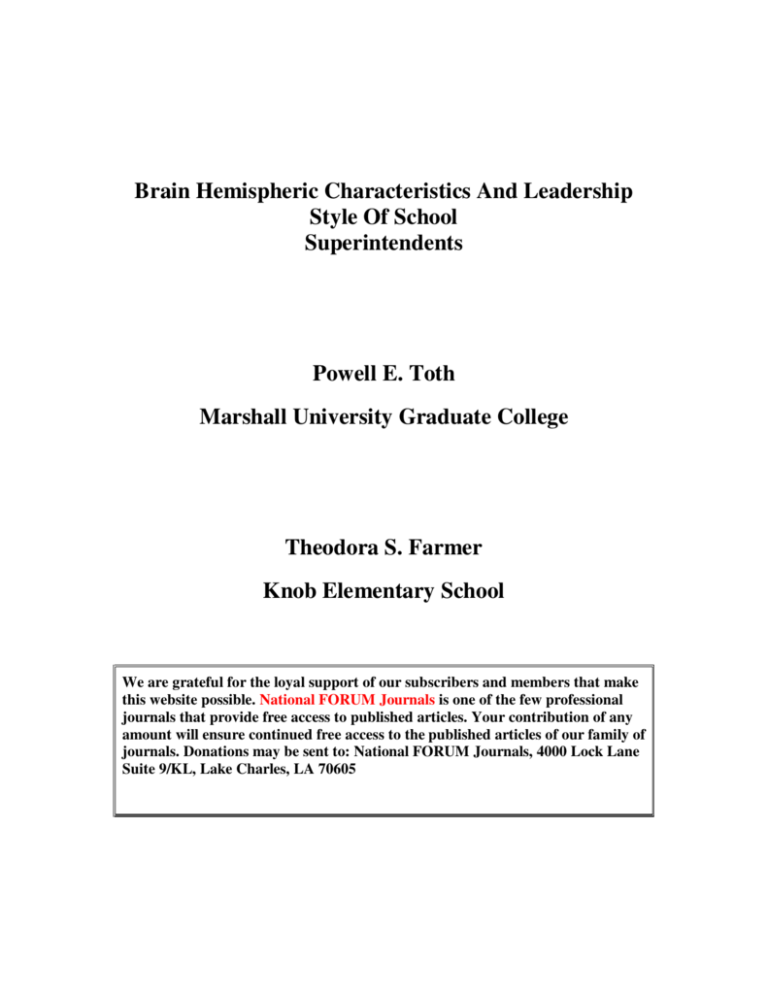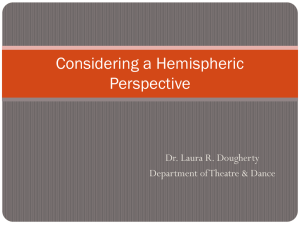Brain Hemispheric Characteristics And Leadership Style Of School
advertisement

Brain Hemispheric Characteristics And Leadership Style Of School Superintendents Powell E. Toth Marshall University Graduate College Theodora S. Farmer Knob Elementary School We are grateful for the loyal support of our subscribers and members that make this website possible. National FORUM Journals is one of the few professional journals that provide free access to published articles. Your contribution of any amount will ensure continued free access to the published articles of our family of journals. Donations may be sent to: National FORUM Journals, 4000 Lock Lane Suite 9/KL, Lake Charles, LA 70605 Abstract This article explores the cognitive processing style and leader style of school superintendents. Analysis of cognitive processing style and leadership style has been explored in the business sector, but little analysis in this area has been done n the field of education. This article is based on a 1997 survey of West Virginia school superintendents. The analysis of self-perceived cognitive processing style compared to self-perceived leader style has been studied in the business sector to determine if these areas serve as possible predictors of effective leadership at the top executive levels of administration (Agor, 1985; Mintzberg, 1976; Peters & Waterman, 1982; Wonder & Donovan, 1984). Extensive research (Kean, 1989; Norris, 1984; Owen, 1986; Soler, 1991) has indicated educators need to study leadership as it relates to brain hemisphericity, specifically at the top executive level of school administration, the office of the superintendent. The superintendency of schools is a crucial and demanding position in American society because the individual in this position is the primary influence in the shaping of public education (Soler, 1991). Chief executive officers of the school districts are required to increase functional organization effectiveness while adjusting to turbulent changes in the world (Davidson, 1987). Exploratory studies by Coulson and Strickland (1983), Norris (1984), and Soler (1991) concluded that school district superintendents need conceptual skills in combination with technical skills to direct the educational system toward new pathways of change. Analysis of cognitive processing style, or brain hemisphericity, and leadership style has been explored in the business sector to determine if this area serves as an indicator for administrative success (Agor, 1984; Mintzberg, 1976; Peters & Waterman, 1982; Spinola, 1988; Wonder & Donovan, 1984). In order to analyze the concept of brain dominance and educational leadership, researchers have conducted studies of right-brain, left-brain thinking and administrative effectiveness (Coulson & Strickland, 1983; Kean, 1989; Norris, 1984; Peters & Waterman, 1982; Soler, 1991). Brain hemisphericity, separate cognitive processing styles, can be identified in every individual, as demonstrated scientifically using electroencephalographic (EEG) techniques (Orstein, 1978). Beginning with the Greek physician Hippocrates, the concept of the duality of the human brain was introduced (Herrmann, 1988). In 1960, neurosurgeon Sperry demonstrated through split brain experiments that the right and left hemispheres are specialized. He conducted studies of epileptic patients who had undergone division of the corpus callosum in its entirety (Sperry, 1964). Specific mental abilities are lateralized and coordinated predominantly in one of these hemispheres (Sperry, 1975). The left side is analytical, verbal, sequential, concrete, and rational; while the right-brain is intuitive, spontaneous, holistic, visual, and symbolic (Wonder & Donovan, 1984). The brain’s two hemispheres can be further organized into four separate and distinct quadrants consisting of the right and left halves of the neocortex and the right and left divisions of the limbic system (Herrmann, 1988). Four quadrant preferences were identified from Herrmann’s research. Quadrant A is the upper left cerebral mode reflecting preferences for analyzing, solving problems logically, and getting facts. Quadrant B, lower left limbic mode, preferences include organizing, arranging, attention to detail, being procedural, precise, and seeking control of the situation (Herrmann, 1988). The upper right quadrant D preferences include risk-taking, imagination exercises, visionary approaches, and new experiences. This thinking style is the most productive in industry and education (Peschanel, 1988). C quadrant, the lower right limbic mode, reflects emotional, spiritual, intuitive preferences surrounding interpersonal experiences (Herrmann, 1988). Fibers that carry the signals of communication to different parts of the brain, the connectors, are divided into those that are links within each hemisphere and those that are links between the hemispheres (Sylwester, 1995). The corpus callosum connects the two cerebral hemispheres and, without this vital bridge, the brain has no way of integrating one mode of awareness with its complement, such as developing a verbal concept from a visual image (Gazzaniga, 1975). In the 1960s, Sperry, along with his associates Bogen, Gazzaniga, and Levy, from the California Institute of Technology, designed a set of tests to isolate and reveal the functions of each hemisphere. This information has revolutionized the understanding of the human brain and earned Sperry a Nobel Prize in 1981 (Gazzaniga, 1975; Levy, 1983). Torrance (1982) conducted interdisciplinary research that recognized the importance of two kinds of information processing that seem to parallel the specialized cerebral functions of the left and right hemispheres. Measures of creative style tend to be positively and significantly related to the right side of the brain (Gowan, 1979). The left hemisphere seems to be specialized for the logical, sequential processing style and deals primarily with verbal, analytical, temporal, and digital materials. The right cerebral hemisphere functions nonlinearly and holistically, simultaneously dealing with a variety of variables and different kinds of information. It is specialized for nonverbal, spatial, emotional, and aesthetic materials (Gazzaniga, 1975). In 1977, Torrance administered a series of tests including his test of creative thinking measuring fluency, flexibility, originality, and creative strengths to 33 graduate students, 13 males and 20 females, enrolled in his class. He determined that a statistically significant relationship exists between innovation and the right hemisphere style of learning and thinking (Torrance & Horng, 1980). An abundance of literature has indicated that an individual’s brain hemispheric processing mode is directly related to that individual’s learning style (Campbell, 1989; Herrmann, 1982A; Jung, 1923; McCarthy, 1991; Torrance & Horng, 1980). These data, combined with research on the human mind and brain, make a compelling case for our school leaders to seriously promote integrative education. Education administrators need to examine traditional programs that ignore one-half of the brain, the long ignored right side (Walker, 1995). Kovalik and Olsen (1994) used brain research to help identify eight conditions that create a right and left brain compatible learning environment. Superintendents and principals can provide support by offering teachers greater autonomy, including full participation in setting policies on materials selection, scheduling, and class size. Administrators can create opportunities for reflection and dialogue among teachers on topics such as standardized testing that addresses competencies developed in an integrative educational setting (Shoemaker, 1991). More training in whole-brain thinking with transference to everyday life promotes a citizenry with more self-awareness and understanding of people, issues, culture, and innovation (Key, 1991). Educators at the higher levels of administration benefit from awareness of cognitive lateral functions and how to integrate them in their decision making as well as how to promote this approach in the training of staff personnel (Mitchell & Tucker, 1992). Torrance and Mourad (1979) indicated creativity and effectiveness result most often from a style of information processing characterized by both hemispheres functioning in a complementary manner. Whole-brained thinkers assimilate facts and issues adeptly by seeing the whole picture, thus viewing the multitude of interrelated circumstances that impact simultaneously one upon another (Carthey, 1993). Superintendents who simultaneously utilize analytic and intuitive approaches are adept at assimilating these vast and current information sources for orchestrating both skillful administrative strategies and leading edge curriculum developments (Coulson & Strickland, 1983; Norris, 1984; Soler, 1991). Recent research indicated that at top management levels, right brain and integrative brain skills characterize effective leaders (Johnson & Daumer, 1993; Spinola, 1988). Superintendents in current educational climates face complex policy issues, and the complete databases necessary for left brain processing are not always available, adequate, or financially feasible. Crises arising from financial constraints, safety issues, societal pressures, or personnel demands make the exclusive use of the left-brain processes increasingly difficult. Peters and Waterman (1982) reported that the 10 best-run companies in America encourage the use of intuitive skills and nurture intuition’s development in their management cultures. Research has indicated that the most successful and innovative leaders integrate both left and right brain processing, thus are more amenable to change, are better able to restore energy resources, are more successful, and are less susceptible to job burnout (Kean, Leary, & Toth, 1993). A right hemispheric function, emotional/intuitive intelligence, is a key to integrating mental processes. School leaders are in the people business and the people skills include empathy, graciousness, and the ability to read a social situation. Researchers indicate about 90% of emotional communication is nonverbal. At the Center for Creative Leadership failed executives were studied and found to be lacking in emotional/intuitive processing skills; consequently, they were authoritarian, too ambitious, and lacking in interpersonal capabilities (Gibbs, 1995). By understanding the brain’s engineering and operations, one can better utilize its power, become a faster, more creative thinker, and reduce the stress and tension associated with high-level executive positions such as the superintendency (Soler, 1991). Mind mapping helps the leader to build mental fitness, especially in the critical leadership areas of clarity of vision, energy, and persistence (Buzan, 1991). Whole-brain thinking, resulting from training in integrating the hemispheres, results in excellence in performance of leaders (Hooper, 1992). The simultaneous use of both processing modes has been demonstrated by subjects following an instructional set to prepare them to switch between one and the other (Boles, 1989). Investigative research reveals that both brain hemisphericity and learning style impact upon the individual’s leadership style (Cameron, 1984; Herrmann, 1982b; Kean, 1989; McCarthy, 1985). Herrmann (1982b) indicated that information generated from the Herrmann Brain Dominance Instrument can be directly related to individual learning and leadership styles. Leaders who use left processing skills develop plans, think logically, set goals, measure results, and seek solutions. Right processing leaders integrate ideas and concepts, are strategic global planners, bend policies, and rely on intuition in decision making (Herrmann, 1982b, 1988). Leaders can be categorized as effective and/or efficient when they are people oriented with styles that emanate from the right or integrated hemisphere (Mitchell & Tucker, 1992). Efficient leaders’ primary interest is for individual relationships (Barnard, 1938). Halpin (1957) and Stogdill (1957, 1974) divided leadership styles into two groups: those exhibiting initiating structure styles and those exhibiting consideration styles. Initiating structure refers to establishing goals, procedures, schedules, and routines. These characteristics are indicative of left-brain cognitive processing and refer to task-oriented leaders. Consideration involves demonstrating concern for people and relationships. This leader style reflects rightbrain cognitive style (Campbell, Corbally, & Nystrand, 1983; Halpin, 1957; Kean, 1989; Stogdill, 1974). These leadership styles can be described as those of task leaders and social leaders (Hoy & Miskel, 1987). The task leader establishes organizational goals for the school system and plans activities according to time tables (Cameron, 1984). The social leader communicates a vision for the system through various groups of the hierarchical structure (Hoy & Miskel, 1987; McCarthy, 1985). Leaders who utilize mostly left hemispheric processing techniques, task oriented individuals, have the following behavior characteristics: determine and record goals; make detailed lists, charts, and graphs; base solutions on existing models; analyze subordinates’ behavior within the environment; strive to maintain status quo; work within the system; gather data and extrapolate from facts; need tasks related to desired outcomes; and evaluate progress (Mintzberg, 1976). Those leaders who prefer right brain processing are process oriented, view problems as opportunities, consider feelings first, may have difficulty following through, need quiet time and personal space, promote brainstorming and group decision-making, and take risks (Mintzberg, 1976). An administrator’s awareness and understanding of brain hemispheric processing can have implications for decision-making, screening, hiring, and job assignments (Agor, 1984; Piatt, 1983); interpersonal relationships (Agor, 1984); pre-service and in-service training (Coulson & Strickland, 1983); and organizational change (Levy, 1983; Piatt, 1983). Studies of intuitive awareness among chief executive officers support the importance of intuitive ability to leadership style (Mintzberg, 1976; Peters & Waterman 1982). Similar studies of educational administrators have confirmed the importance of this ability being part of an effective leader’s cognitive style. The consideration style leader who utilizes this cognitive model is creative and visionary in decision-making (Halpin, 1957; Stogdill, 1974). Leadership may be viewed as a process through which others are motivated to accomplish goals. The important elements of leadership are the behavior of the leader, the behavior of the followers, and the environment of the situation (Owen, 1986). Leader behaviors can be thought of in a two-dimensional theory: (a) the leader can decide what to do and tell followers how to do it, or (b) the leader can permit followers to operate freely within limits dictated by things over which he or she has no control (Katz, 1974). The leader who decides and tells has an authoritarian orientation toward followers, whereas the leader who permits followers to operate freely has a human relationship point of view. Simplified, these two leadership styles can be identified as being either task-oriented or people-oriented (Hoy & Miskel, 1987). Leadership style evidenced by a specific leader is a combination of task-oriented behavior and peopleoriented behavior. Some leaders are very task-oriented and some are much more concerned about human relationships. Most leaders exemplify a balance of the two behaviors somewhere in between (Halpin, 1966). Cartwright and Zander (1960) identified these two characteristics in research on leader behavior. One dimension is concerned with the achievement of some specific group goal, and the other is concerned with the maintenance of strengthening of the group itself. Katz (1974) referred to the dimensions of leadership as employee-orientation and product-orientation. Likert (1961) used the term employee-centered to describe the focus on human relationship skills with groups, and the term job-centered in referring to emphasis on achieving group goals. The Ohio State Leadership Studies, begun by the Bureau of Business Research in 1945, called them initiating structure and consideration (Stogdill, 1974). Halpin (1966) used these terms to describe the leader behavior of school superintendents. In his description, initiating structure refers to the leader’s behavior in delineating the relationship between self and the members of the work group, and in endeavoring to establish well defined patterns of organization, channels of communication, and methods of procedure. Consideration refers to behavior indicative of friendship, mutual trust, respect, and warmth in the relationship between the leader and the members of the staff (Halpin, 1966). In order to move from competence to excellence in school systems, leaders must provide symbolic leadership (Sergiovanni, 1984). Through symbolic leadership, top level education administrators signal and demonstrate what is valued and what goals override all others. These leaders communicate a vision for followers. The symbolic school district leader provides a clear and unified vision of the organization, thus establishing a sense of order and direction (Halpin & Croft, 1967). The chief executive officer is the focal point and determiner of change in an organization (Weick, 1982). In times of strategic change, the organization must be able to look to the leader for vision and purpose (Paulson, 1982; Weick, 1982). The superintendent’s proximity to education personnel and to community spokespersons provides him/her with opportunity to fulfill the change mission (Owens, 1970). The many aspects of the school executive’s role and the complex problems which confront school superintendents require leaders who are capable of making effective decisions that will have positive outcomes for their school systems. Truly effective leadership results from the integrated processing modes of logic and intuition, analysis, and conceptualization (Norris, 1984; Soler, 1991). This study was designed to examine the relationship between preferred brain hemispheric processing, as established by the Herrmann Brain Dominance Instrument (HBDI), of public school superintendents and their preferred leadership styles, as measured by the Leadership Behavior Description Questionnaire (LBDQ). The following hypotheses guided the study: 1. Public school superintendents who perceive themselves as preferring predominantly left hemispheric processing will manifest significantly higher selfperceived Initiating Structure scores than superintendents who perceive that their mental processing is predominantly right hemispheric. 2. Public school superintendents who perceive themselves as preferring predominantly right hemispheric processing will manifest significantly higher selfperceived Consideration scores than superintendents who perceive that their mental processing is predominantly left hemispheric. The first hypothesis was not supported by the collected data. Only 35% of the superintendents who perceived themselves as preferring predominantly left hemispheric processing perceived themselves as being Initiating Structure leadership style. The second hypothesis was supported by the descriptive data. Eighty-two percent of the superintendents who perceived themselves as preferring predominantly right hemispheric processing perceived themselves as being Consideration leadership style. The sample for this study was 55 public school superintendents. A demographic questionnaire, two survey instruments, and a stamped, self-addressed envelope were mailed to each superintendent. Two instruments were used to collect data. The first instrument, Herrmann’s Brain Dominance Instrument (1982), measured self-perceived mental processing in the left and right brain hemispheres. The second instrument, Leader Behavior Description Questionnaire-Self (1957), measured two different dimensions of self-perceived leadership behavior. A total of 35 (64%) superintendents returned the questionnaires with a usable return rate of 33, or 60%. Data generated by the study were assigned response codes, transferred to a computer file, verified for processing, and statistically analyzed by using the General Linear Model of the Statistical Analysis System (SAS). In addition to the survey instruments described, the participants were asked to complete demographic information related to gender, age, educational level, education experience prior to the superintendency, and administrative experience as a superintendent. These data were tabulated to identify the "typical" superintendent in the respondent group. The average respondent of the group of superintendents was 45 to 65 years of age, had acquired more than 30 hours of study beyond the Master’s Degree, and had over 20 years experience in education. Also, the average respondent had accumulated less than 10 years experience in the office of superintendent and governed a school district of 10,000 or fewer students. Data also revealed that 30 males and 3 females made up the respondent group. Of the males, 16 (53%) preferred predominantly left hemispheric processing, 9 (30%) preferred right processing, and 5 (17%) preferred integrated hemisphericity. Of the females, 2 (67%) preferred predominantly right hemispheric processing, and 1 (33%) preferred predominantly left hemispheric processing. Further analysis of the data determined that over half of the superintendents (18, 55%), were 45 years of age or older, and 12 (36%) were over 55 years of age. Fourteen (42%) superintendents had doctorate degrees, and 18 (55%) had higher than a Master’s + 30 hours. Twenty-six (79%) superintendents had over 25 years of experience in the field of education, and 6 (18%) had up to 25 years. A majority (18, 55%) of the respondent group superintendents worked in a school district of 5,000 or fewer student population and 10 (30%) had school districts of 5,000 to 10,000 students. Fourteen (42%) superintendents had 6 to 10 years experience in the position, 9 (27%) had less than five years experience, 4 (12%) had 16 to 20 years experience, 3 (9%) had 21 to 25 years experience, and 2 (6%) had over 25 years experience as superintendents. Public school superintendents who perceived themselves as preferring predominantly left brain hemispheric processing perceived themselves to be predominantly Consideration leadership style. Public school superintendents who perceived themselves as preferring predominantly right brain hemispheric processing perceived themselves to be predominantly Consideration leadership style. Seventeen superintendents indicated a self-perceived preference for mental processing that was predominantly left hemispheric, 11 superintendents indicated a self-perceived preference for mental processing that was predominantly right hemispheric, and 5 superintendents indicated a self-perceived preference for mental processing that was integrated with equal preference for both hemispheres. Of the 17 superintendents who preferred left hemispheric processing, 10 preferred Consideration style leadership, 6 preferred Initiating Structure, and 1 preferred an integrated leader style. Of the 11 superintendents who preferred right hemispheric processing, 9 preferred Consideration style leadership and 2 preferred Initiating Structure style leadership. Of the 5 superintendents who preferred integrated hemispheric processing, 3 preferred Consideration style leadership, 1 preferred Initiating Structure style leadership, and 1 preferred an integrated leader style. Of the 3 female superintendents in the respondent group, 2 preferred right hemispheric processing and Consideration leadership style, while 1 preferred left hemispheric processing and Initiating Structure leadership style. Two female superintendents were from small school districts of 1,000 to 5,000 students, while 1 female superintendent was from a larger district of 10,000 to 15,000 student population. The findings of this study provided data from which a number of conclusions may be drawn through analysis of the demographic statistics and the surveys utilized. Based on the computed percentages and frequencies, there appears to be a relationship between superintendents’ self-perceived brain hemispheric processing and their self-perceived leadership styles in the category of right brain hemisphericity. Superintendents who preferred right hemispheric processing (conceptual, synthesizer, interpersonal, holistic) usually demonstrated a preference for Consideration leadership style (people oriented). However, the majority of superintendents who preferred left hemispheric processing did not demonstrate a preference for Initiating Structure leadership style (task-oriented). Some of the literature indicated that individuals who prefer left hemispheric processing will be taskoriented and that individuals who prefer right hemispheric processing will be people-oriented (Agor, 1984; Herrmann, 1988; Piatt 1983). This study included a small respondent group, therefore it is not valid to make inferences or generalizations about other populations. The position of the superintendent has become more politically defined since they must address more frequently the issues of diverse interest groups (Blumberg & Blumberg, 1985). This may explain why the respondent group has demonstrated a majority (67%) of people oriented, Consideration style leaders, even though many (51%) of the respondents demonstrate a preference for left hemispheric processing. These leaders in education need visionary, people-oriented skills to empower groups to implement constructive change; 67% of the surveyed superintendents display preferences for people-oriented leadership styles. Summary Restructuring of schools is a major focus of today’s educational environments that requires both change and planning. These crucial elements of moving toward innovative organizational strategies require both logical, analytical skills (left processing) and conceptual, visionary abilities (right processing) (Herrmann, 1988). School administrators should be trained to identify individuals’ mental styles and assign them the appropriate tasks. The Consideration style leader and integrated hemispheric thinker embodies the skills to champion the vision for the future of education. This leader works with the group to set goals to give substance to the educators’ dreams and empowers the group to accept the vision as its own. Policy formation, site-based management, and organizational change are all facets of the movement in education to implement the national impetus to better prepare students for the society of the next century. Knowledge, training, and awareness of mental processing styles and leader styles and how they impact administrative effectiveness could assure a positive movement forward to the accomplishment of that goal. References Agor, W.H. (1984). Intuitive management: Integrating left and right brain management skills. Englewood Cliffs, NH: Prentice-Hall. Agor, W.H. (1985). Managing brain skills to increase productivity. Public Administration Review, 45, 864-869. Barnard, C.I. (1938). Mind in everyday affairs. Lecture at Princeton University. In C. Barbard (1968) Functions of the executive. MA: Harvard University Press. Blumberg, A., & Blumberg, P. (1985). The school superintendent living with conflict. New York: Teachers College Press. Boles, D. (1989). Word attributes and lateralization revisited: Implications for dual coding and discrete versus continuous processing. Memory and Cognition, 17(1), 106-114. Buzan, T. (1991). Train your brain: Mental literacy skills in the workplace. Management Review, 80(28), 53-54. Cameron, K. (1984). The paradox in institutional renewal. Leadership and institutional renewal: Jossey-Bass. (ERIC Document Reproduction Service, 357-351) Campbell, R., Corbally, J., & Nystrand, R. (1983). Introduction to educational administration (6th ed.). Boston: Allyn & Bacon. Campbell, J. (1989). The improbable machine. New York: Simon & Schuster. Carthey, J. (1973). Relationship between learning styles and academic achievement and brain hemispheric dominance and academic performance in business. MS thesis, Winona State University. Cartwright, D., & Zander, A. (1960). Group dynamics: Research and theory (2nd ed.). Evanston: Row, Peterson, & Company. Coulson, L.T., & Strickland, A.G. (1983). The minds at the top: An analysis of the thinking style preferences of superintendents of schools and chief executive officers. Journal of Creative Behavior, 17, 163-174. Davidson, J.L. (1987). The superintendency: Leadership for effective schools. Jackson: Kelwynn Press. Gazzaniga, M. (1975). Review of the split brain. Journal of Neurology, 209, 75-79. Gibbs, N. (1995, October). The EQ factor. Time, 60-68. Gowan, J.C. (1979). The production of creativity through right hemisphere imagery. The Journal of Creative Behavior, 13, 3951. Halpin, A.W. (1957). Manual for the leader behavior description questionnaire. Columbus: The Ohio State University. Halpin, A.W. (1966). Theory and research in administration. New York: Macmillian. Halpin, A., & Croft, D. (1967). The organizational climate of schools. US Office of Education Project, 543-8639. Herrmann, N. (1982a). The creative brain. NASSP Bulletin, 66, 31-46. Herrmann, N. (1982b). The brain and management learning. The Bureaucrat, 11, 17-20. Herrmann, N. (1988). The creative brain. Lake Lure, NC: Brain Books. Hooper, D. (1992). Success depends on leaders’ whole brain thinking. School Administrator, 49(6), 14-17. Hoy, W.K., & Miskel, C.G. (1987). Educational administration: Theory, research, and practice (3rd ed.). New York: Random House. Johnson, P.R., & Daumer, C.R. (1993). Intuitive development: Communication in the nineties-developing the right brain hemisphere. Public Personnel Management, 22, 257-268. Jung, C. (1923). Psychological types. New York: Harcourt, Brace, & World. Katz, R.L. (1974). Skills of an effective administrator. Harvard Business Review, 52(5), 90-102. Kean, B. (1989). The relationship between school principals’ self-perceived hemispheric processing modes and their self-perceived leadership styles. (Doctoral dissertation, West Virginia University, 1989). Dissertation Abstract International. Kean, B., Leary, P., & Toth, P. (1992-93). School principals, left-brain, right-brain leadership. National FORUM of Applied Educational Research Journal, 5(2), 69-73. Key, N. (1991). Research and methodologies for whole-brained integration at the secondary level. Report prepared for Teacher Researchers, September 1991. (ERIC Document Reproduction Service No. 347-141) Kovalik, S., & Olsen, K. (1994). ITI: The model, integrated thematic instruction (3rd ed.). Kent, WA: Books for Education. Levy, J. (1983). Research synthesis on right and left hemispheres: We think with both halves. Educational Leadership, 40, 66-71. Likert, R. (1961). New patterns in management. New York: McGraw Hill. McCarthy, B. (1985). What 4Mat training teaches us about staff development. Educational Leadership, 42, 61-68. Mintzberg, H. (1976). Planning on the left side and managing on the right. Harvard Business Review, 54, 59-68. Mitchell, D., & Tucker, S. (1992). Leadership as a way of thinking. Educational Leadership, 49(5), 30-35. Norris, C. (1984). A discussion of brain hemisphere characteristics and creative leadership among selected educational administrators in Tennessee. (Doctoral dissertation, University of Tennessee, 1984). Dissertation Abstracts International. Orstein, R. (1978). The split and the whole-brain. Human Nature, 1, 76-83. Owen, G.B. (1986). The relationship of left-right brain dominance, administrative experience, and mentorship to the leadership style of elementary school principals. (Doctoral dissertation East Texas State University). Dissertations Abstracts International, 47, 04a. Owens, R.G. (1970). Organizational behavior in schools. NJ: Prentice Hall. Paulson, R.D. (1982). The chief executive as change agent. Management Review, 71(2), 25-42. Peschanel, F. (1988). Brain dominance and productivity. International Brain Dominance Review, 5(2), 6-11. Peters, T.J., & Waterman, R.H. (1982). In search of excellence. New York: Harper & Row. Piatt, J.G. (1983). Brain processing preferences: Key to an organizations success. NASSP Bulletin, 67, 64-69. Sergiovanni, T. (1984). Leadership and excellence in schooling. Educational Leadership, 41(5), 4-13. Shoemaker, B. (1991). Education 2000: Integrated curriculum. Phi Delta Kappan, 72(10), 793-97 Soler, E. (1991). Brain hemispheric characteristics and leadership style of selected school superintendents in Texas. (Doctoral dissertation, University of Texas, 1991). Dissertation Abstracts International. Sperry, R.W. (1964). The great cerebral commissure. Scientific American, 210, 42-52. Sperry, R.W. (1975). Left-brain, right-brain. Saturday Review, 2, 30-33. Spinola, R. (1988). Characteristics of corporate cultures as expressed by brain dominances. International Brain Dominance Review, 5(2), 22-28. Stogdill, R.M., & Coons, A.E. (1957). Leadership behavior: Its description and measurement. Columbus: Ohio State University. Stogdill, R.M. (1974). Handbook of leadership. New York: The Free Press. Sylwester, R. (1995). An educator’s guide to the human brain: A celebration of neurons. New York: ASCD. Torrance, E.P. (1982). Hemisphercity and creative functioning. Journal of Research and Development in Education, 15, 29-37. Torrance, E.P., & Horng, R.Y. (1980). Creativity and style of learning and thinking characteristics of adaptors and innovators. The Creative Child and Adult Quarterly, V, 80-85. Torrance E.P., & Mourad, S. (1979). Role of hemisphericity in performance on selected measures of creativity. The Gifted Child Quarterly, 23(1), 44-45. Walker, D. (1995). Integrative education. Research and Roundup, 12(1), 1-4. Weick, K.E. (1982). Administering education in loosely coupled schools. Phi Delta Kappan, 63(10), 673. Wonder, J., & Donovan, P. (1984). Whole brain thinking. New York: Ballantine.






